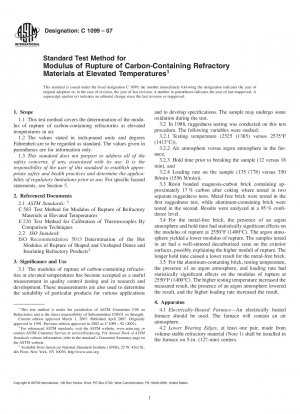ASTM C1099-07
Standard Test Method for Modulus of Rupture of Carbon-Containing Refractory Materials at Elevated Temperatures
- Standard No.
- ASTM C1099-07
- Release Date
- 2007
- Published By
- American Society for Testing and Materials (ASTM)
- Status
- Replace By
- ASTM C1099-07(2012)
- Latest
- ASTM C1099-07(2019)
- Scope
The modulus of rupture of carbon-containing refractories at elevated temperatures has become accepted as a useful measurement in quality control testing and in research and development. These measurements are also used to determine the suitability of particular products for various applications and to develop specifications. The sample may undergo some oxidation during the test.
In 1988, ruggedness testing was conducted on this test procedure. The following variables were studied:
3.2.1 Testing temperature (2525 (1385) versus 2575°F (1413°C)),
3.2.2 Air atmosphere versus argon atmosphere in the furnace,
3.2.3 Hold time prior to breaking the sample (12 versus 18 min), and
3.2.4 Loading rate on the sample (175 (778) versus 350 lb/min (1556 N/min)).
Resin bonded magnesia-carbon brick containing approximately 17 % carbon after coking where tested in two separate ruggedness tests. Metal-free brick were tested in the first ruggedness test, while aluminum-containing brick were tested in the second. Results were analyzed at a 95 % confidence level.
For the metal-free brick, the presence of an argon atmosphere and hold time had statistically significant effects on the modulus of rupture at 2550°F (1400°C). The argon atmosphere yielded a lower modulus of rupture. The samples tested in air had a well-sintered decarburized zone on the exterior surfaces, possibly explaining the higher moduli of rupture. The longer hold time caused a lower result for the metal-free brick.
For the aluminum-containing brick, testing temperature, the presence of an argon atmosphere, and loading rate had statistically significant effects on the modulus of rupture at 2550°F (1400°C). The higher testing temperature increased the measured result, the presence of an argon atmosphere lowered the result, and the higher loading rate increased the result.
1.1 This test method covers the determination of the modulus of rupture of carbon-containing refractories at elevated temperatures in air.
1.2 The values stated in inch-pound units and degrees Fahrenheit are to be regarded as standard. The values given in parentheses are for information only.
1.3 This standard does not purport to address all of the safety concerns, if any, associated with its use. It is the responsibility of the user of this standard to establish appropriate safety and health practices and determine the applicability of regulatory limitations prior to use. For specific hazard statements, see Section 5.
ASTM C1099-07 Referenced Document
- ASTM C583 Standard Test Method for Modulus of Rupture of Refractory Materials at Elevated Temperatures
- ASTM E220 Standard Test Method for Calibration of Thermocouples By Comparison Techniques
ASTM C1099-07 history
- 2019 ASTM C1099-07(2019) Standard Test Method for Modulus of Rupture of Carbon-Containing Refractory Materials at Elevated Temperatures
- 2007 ASTM C1099-07(2012) Standard Test Method for Modulus of Rupture of Carbon-Containing Refractory Materials at Elevated Temperatures
- 2007 ASTM C1099-07 Standard Test Method for Modulus of Rupture of Carbon-Containing Refractory Materials at Elevated Temperatures
- 1992 ASTM C1099-92(2002) Standard Test Method for Modulus of Rupture of Carbon-Containing Refractory Materials at Elevated Temperatures
- 1997 ASTM C1099-92(1997) Standard Test Method for Modulus of Rupture of Carbon-Containing Refractory Materials at Elevated Temperatures
